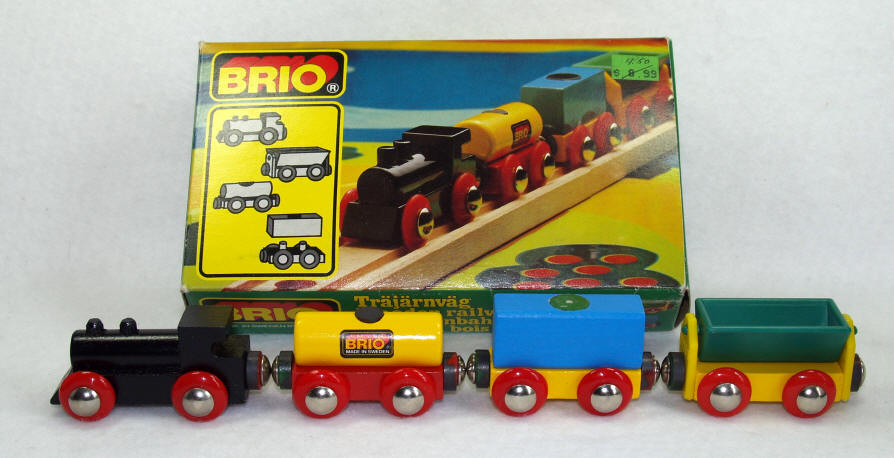All About Old Toys
Brio Trains
Article by
Dave Pecota
|
BRIO AB If there is one toy company that has become synonymous with wooden train sets world-wide … it is BRIO. This well-known Swedish company began making toys in 1907 and started selling “miniature railway” sets in 1957 (primarily for the European marketplace). From the start, the BRIO sets had many similarities to the train sets
made by Skaneateles Handicrafters. The
trains were virtually the same size ... round-head metal tacks were used to
attach the wooden wheels ... and metal hook-eye couplers were used to link the
trains.
More importantly however, each company’s hardwood track looked nearly identical, except for the connectors. SH used a straight-cut connector design … BRIO used the now-familiar “peg and hole” design. Each company’s trains could run happily on either type of track. You just couldn’t directly connect SH and BRIO track together. BRIO’s design actually provided more lateral “play” in the track, which allowed more track layout flexibility. The two companies also differed in the “finish” they applied to their trains. SH used a bees-wax coating on natural wood ... BRIO used glossy, multi-layer lacquer paints. By 1964, BRIO customers could choose to buy trains with either hook-eye couplers or “floating” flat-disk magnetic couplers (an important innovation for these little train sets). In 1974, BRIO received a US patent for “fixed” magnetic couplers which are secured by round-head metal tacks ... today’s most commonly used wood train coupler design. And in 1977, BRIO opened the doors on its US subsidiary BRIO Corporation, in Milwaukee WI. Pictured here are two vintage BRIO trains (ca. 1960’s) showing the two early coupler designs and the peg and hole track. Also pictured is a personal favorite of the author … a box-cab engine with tiny pantographs on the cab roof (ca. 1978). The unusual low-roof passenger cars may have only been available in this set. Wooden railway sets became one of BRIO’s most successful product lines, and have been in continuous production for over 50 years. The BRIO-style peg and hole track connector is probably today’s most widely used wooden track connector design. One can also conclude that the parallel and sustained sales successes of the SH sets in the US and the BRIO sets in Europe, probably ensured future wooden train set compatibility world-wide.
|
 |
|
|
BRIO Harbour Set From my earliest days as a wood train collector, I realized there was not a great deal of readily available historical information about these great toys. So I became a self-professed researcher, as well as collector. Not only did I want to determine which trains to look for, I also wanted to gather information that was historically accurate. As a result, I have been searching for catalogs, ads, articles and other ephemera as diligently as I search for the trains. While owning a catalog is not nearly as much fun as owning a vintage train, knowledge is its own reward, as they say. Luckily, one of the first catalogs I found was a BRIO dealer’s catalog from 1964. I took a great deal of time “digesting” all the information it contained. Top on my list of “must-have” toys from this catalog was a train included with the 31405/40 Harbour Set. This particular train is unusual because of its natural wood finish. Only the wheels and smokestack were painted. In the opening pages of catalog, BRIO states that “children love clear, clean colours” and “children have a love of contrasts”. All of which makes one curious why BRIO chose to use so little paint on one of their largest sets. So I made a mental note in capital letters … “FIND THIS TRAIN”. However, after 7 years of futile searching, the mental note had become covered in cobwebs. I never saw one … never saw photos of one … never saw any identifiable individual components of one. But recently I was not only able to find photos of this set … I was able to add the set to my collection. (Proof that patience IS a virtue in collecting!) As you can see, the train is quite elegant and attractive in its “natural” finish. It’s certainly a “contrast” from the brightly colored trains and vehicles usually associated with the BRIO brand. According to my catalog archives, there appears to be several pieces that were only found in this set … such as the little lighthouses and wharf tracks. However, BRIO has a way of cleverly repurposing some items, so it wouldn’t surprise me that they showed up in other sets … or other toys. The train itself was not available for separate sale at the time, but the 2 ships could be purchased as part of a 3-piece set that also included a barge.
My set was only missing 2 pieces … 2 sections of “standard” curve track. Whew! How hard can it be to find a couple track pieces?? (In a word … hard.) Even the early BRIO track had design variations. So that particularly search will go on.
|